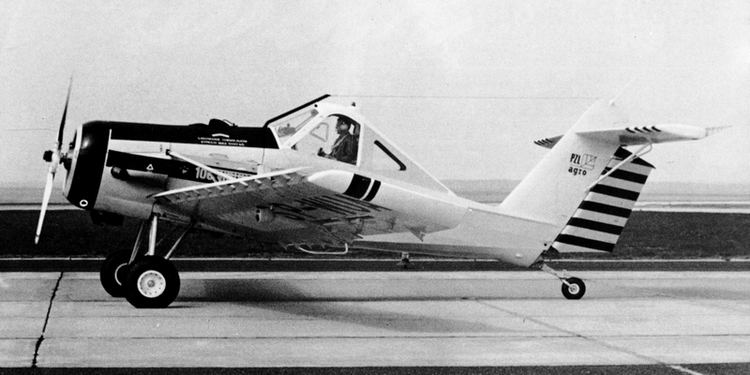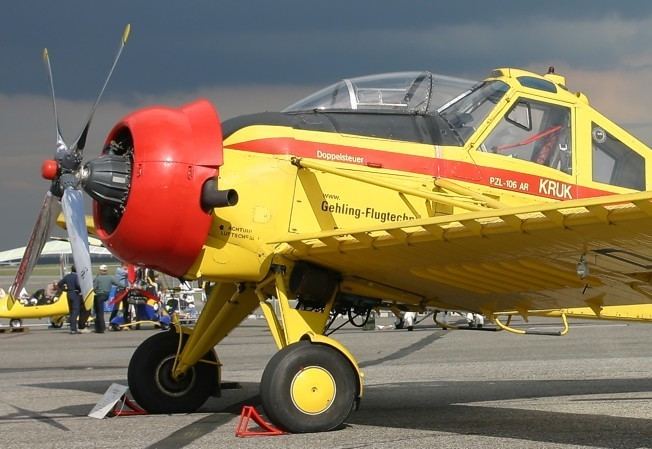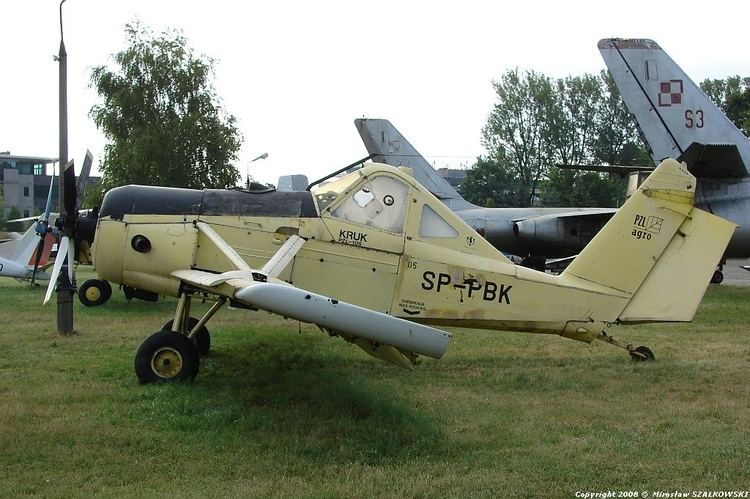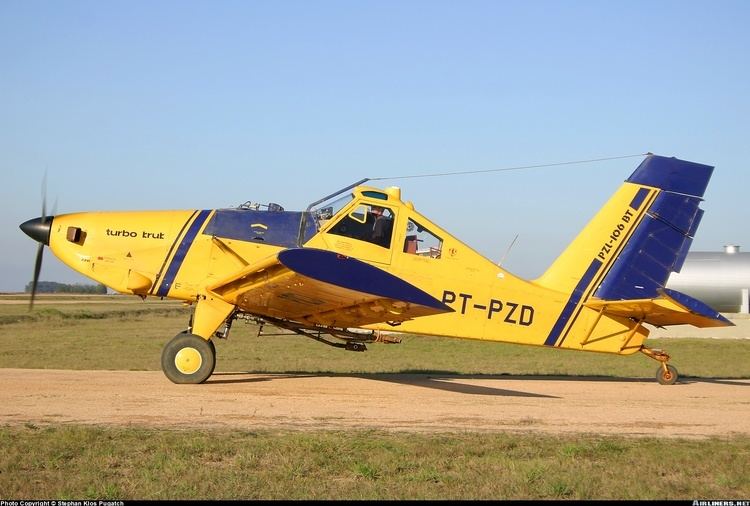Top speed 215 km/h Length 9.25 m | Wingspan 15 m Manufacturer PZL | |
 | ||
Huge pzl 106 kruk with moki radial engine aerotowing
The PZL-106 Kruk (English: Raven) is a Polish agricultural aircraft designed and built by WSK PZL Warszawa-Okęcie (later PZL "Warszawa-Okęcie" and now EADS-PZL).
Contents
- Huge pzl 106 kruk with moki radial engine aerotowing
- Design and development
- Description
- Operational history
- Variants
- Operators
- Specifications PZL 106BR
- References

Design and development

The PZL-106 was developed as a modern agricultural aircraft for Poland and Comecon countries, to replace the less capable PZL-101 Gawron and aging PZL Antonov An-2. (According to Comecon decisions, Polish industry was responsible for developing agricultural aircraft). There were several agricultural plane designs proposed in the early 1960s by a group of young designers from WSK PZL Warszawa-Okęcie, led by Andrzej Frydrychewicz. These proposals were made on their own initiative, but never realized because the USSR was content with the An-2 and was planning to replace it with a jet aircraft (later PZL M-15 Belphegor). The first was the PZL-101M Kruk 63 of 1963. That remained a paper aeroplane, but did give its name to later designs. Next were the PZL-106 Kruk 65 (1965), PZL-110 Kruk-2T (1969) and PZL M-14 Kruk (1970, it was planned to produce this variant in PZL-Mielec). Only in 1971 did the authorities decide to start development of the new agricultural design as the PZL-106 Kruk 71. Despite this decision, its development was quite protracted, due to both economic and political reasons. The work, led by Andrzej Frydrychewicz, started in 1972, and was based on earlier designs. The first prototype was flown on April 17, 1973. The designers chose a safe layout of a braced low-wing monoplane with a container for chemicals in front of the pilot, and was inspired by planes like Piper PA-25 Pawnee (in case of an emergency landing, the container would not crush the higher sitting pilot).

The first prototype was powered by an imported 298 kW (400 hp) Lycoming IO-720 flat-eight-cylinder engine and had a T-tail with wings of wooden construction. There were several prototypes built, and the plane was finally fitted with a 441 kW (600 hp) PZL-3S radial engine, a conventional tail and metal wings. The prototype with the final engine first flew on 25 October 1974.

Production started in 1976 under the designation PZL-106A. Successive variants were the PZL-106AR, with PZL-3SR engine and the PZL-106AS with a stronger 736 kW ASz-62IR radial engine. By 1982, 144 PZL-106As had been built. Several aircraft were modified in Africa to PZL-106AS standard.

On May 15, 1981 the prototype of an improved variant PZL-106B was flown with redesigned wings using shorter struts. It was powered by the same PZL-3SR engine and was produced from 1984. In 1982 the prototype of the PZL-106BS flew powered by the ASz-62IR engine. By 1988, 60 PZL-106Bs had been built.
The next step was fitting the Kruk with a turboprop engine. The first was the PZL-106AT Turbo Kruk prototype, with a 566 kW (770 hp) Pratt & Whitney PT6A-34AG engine in 1981. The next version, based upon the PZL-106B, was the PZL-106BT Turbo Kruk with a 544 kW Walter M601D-1 engine. The PZL-106BT first flew in 1985 and was only produced in limited numbers (10 in 1986–1988). The last variant, in 1998, was the PZL-106BTU-34 Turbo Kruk with a Pratt & Whitney PT6A-34AG engine. Both turboprop variants have a taller tailfin, and the BTU-34 differs again with a restyled nose, a bigger fuel tank (780 l), revised cockpit layout and improved performance.
In total, 266 PZL-106s were produced. Production was restarted in 1995 and as of 2007, the PZL-106BT (renamed PZL-106BT-601) with the Walter M601-D1, and the PZL-106BTU-34 with the PT6A-34AG engine are currently being offered by the manufacturer EADS-PZL. Limited numbers of turbo-Kruks have been produced so far.
Description
Metal construction braced low-wing monoplane, conventional in layout. Fuselage is a steel frame, covered with duralumin (front) and canvas (tail). Wings duralumin and canvas covered, fitted with flaps and slats. Single seat cabin, placed high, with an emergency seat for a mechanic behind the pilot. Behind the engine is a 1300-litre container for 1050 kg of chemicals, with interchangeable equipment sets for spraying, cropdusting or fire-fighting. The container might be replaced with an additional cab for an instructor for pilot training. Conventional fixed landing gear with a tail wheel.
Single radial engine PZL-3S or SR (600 hp / 441 kW), four-blade propeller or turboprop engine with three-blade propeller (554 kW Walter M601D-1 or PT6A-34AG). Fuel tanks for 540 l, or from serial number 260 onwards, 760 l.
Operational history
Main user of the PZL-106 was the Polish civilian aviation. At that time, Polish state aviation firms often carried out agricultural services abroad, especially in Egypt and Sudan. They were supplemented and partly superseded by the PZL-Mielec M-18 Dromader. PZL-106A and Bs were exported to East Germany (major non-Polish user - 54), Czechoslovakia, Egypt, Hungary, Argentina, Brazil, and Ecuador. Some PZL-106BT-601s were sold to Egypt, Ecuador (2 Operational till 2008), Argentina (30 operational till 2008) and Brazil (4 operational till 2008). The PZL 106BT-34 is still flying in Argentina.
Variants
Operators
Specifications (PZL-106BR)
Data from Jane's All The World's Aircraft 1988–89
General characteristics
Performance
